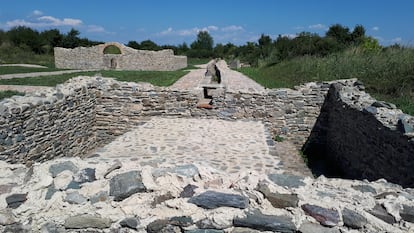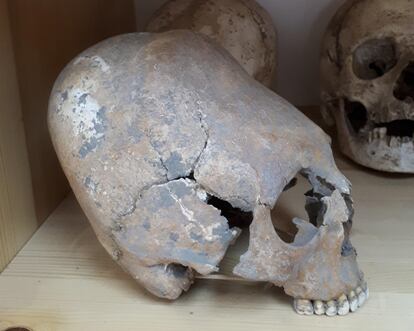Ancient DNA study questions the genetic purity of Balkan Slavs
The results of past genetic analyzes have frequently been used to defend nationalist political positions

Many of the myths on which modern European nations are founded arise in the well-known era of the great migrations, shortly after the fall of Rome and up to the year 1,000 AD. At that time, around 722 AD, the Battle of Covadonga took place, with which the Visigoths, supposedly, began the reconquest of the Iberian Peninsula. France was victorious in the Battle of Tours against the Muslim forces of the Umayyad Caliphate around the same date, and the Hungarians recall their arrival in the area that now comprises their country from Asia a century later. Many of the stories told about that time, which is not well-documented, were recorded in accounts written much later, or reconstructed from archaeological sites. The study of ancient genetics, which makes it possible to investigate the lineage of those peoples, has become a tool to better reconstruct history and, in some cases, to question myths. This week, a paper published in the journal Cell shows what DNA reveals about the current and past populations of the Balkans, a region where ethnic identity has sparked intense conflict.
The researchers extracted DNA from 136 individuals drawn from 20 sites, which included major Roman cities, military camps, and some rural localities. The study was divided into three phases: the period of imperial expansion (1-250 AD), the late empire (250-550 AD) and the centuries after the collapse of Rome (550-1000). In the first stage, historians — who together with local archaeologists collaborated in the study — were surprised by the absence of Italian ancestry. Instead, that empire, in which the first instance of globalization took place, was populated by people from the region that is now Turkey, central and northern Europe, or the steppe stretching north of the Black Sea. This may be because although the capital, Rome, was in the west, the eastern part of the empire was much more populated.
One of the cities studied was Viminacium, on the Danube in present-day Serbia. With more than 40,000 inhabitants in its heyday, it was also a large military camp. Eighteen Roman emperors were born in this frontier region, at a time when the best warriors were chosen for the post, including Constantine I, the emperor who ended the persecution of Christians in the 4th century. The body of a young man analyzed in the study from that first stage is around 16 years old, from East Africa, in present-day Ethiopia or Sudan, far beyond the limits of the empire. “From the 3rd and 4th centuries, in Viminacium, we found a mixture of Germanic and people from the steppes, some with deformed skulls, because the Huns did that with children to differentiate the elites,” says Carles Lalueza-Fox, a researcher at the Institute of Evolutionary Biology of Barcelona and co-author of the study.

The invasions of the Slavs, around the 6th century, destroyed Viminacium, which was never rebuilt. Today it is a gigantic archaeological site where more than 10,000 tombs have already been excavated. As Lalueza-Fox explains, it is in the period after the arrival of the Slavs that DNA provides the most sensitive information, especially because of the possible political implications. Although genetics confirms the weight of the Slavic arrival, the admixture with Mediterranean populations remains at approximately 50%, an unsatisfactory result for some. “When I went to explain the preliminary results to the Serbian National Academy of Sciences, there were academics who did not agree with the results because they had the idea that there are only Slavs, and with these results you could claim a Mediterranean identity in the same way,” recalls the researcher. This ancestry shows the effects of the invasion of those barbarians who entered through the Danube from the north and went on to populate the Balkans towards the south, reaching what is now Greece, including the Aegean Islands.
Ethnic identity often has political consequences. The Serbs are southern Slavs and there is an affinity there with Russia, including its policy in Ukraine, which far outweighs that of the rest of Europe. “There is an official interpretation of Pan-Slavic archaeology, from a time when they were going to be formed in Russia, which wants to believe that they are 100% Slavic,” continues Lalueza-Fox. Studies like the one presented on December 8 by Cell have already been used for political purposes.
In 2019, Israeli Prime Minister Benjamin Netanyahu reacted to the publication in Science Advances of the results of the analysis of DNA from 3,200 years ago at a Philistine site in Ashkelon, in present-day Israel. In a series of tweets that show the interest of these studies for nationalist politicians, he stated that the study “confirms what we know from the Bible,” and that the DNA confirmed the origin of the Philistines in southern Europe, ruling out the relationship between these people and the Palestinians. “The Palestinians’ connection to the Land of Israel is nothing compared to the 4,000-year connection that the Jewish people have with the land,” he concluded.
Another similar case is related by Howard Wolinski in an article published in Embo Reports magazine. In 2019, Miklós Kásler, director of the Hungarian National Institute of Oncology, published the genetic analysis of the remains of 12th-century King Bela III and observed that the monarch’s mitochondrial DNA belonged to a group with a wide distribution across Europe and Asia. Kásler, however, interpreted his own findings more dramatically in statements to the nationalist newspaper Magyar Idők, asserting that his results showed that the house of Árpad, founder of the Kingdom of Hungary, was of Eurasian provenance. This interpretation supports the account of President Viktor Orbán, who places the origin of his nation among the warriors of Attila’s Huns. Kásler was later appointed minister by Orbán and created the Institute for Hungarian Studies, which has raised concerns about the use of science for political purposes.
Sign up for our weekly newsletter to get more English-language news coverage from EL PAÍS USA Edition
Tu suscripción se está usando en otro dispositivo
¿Quieres añadir otro usuario a tu suscripción?
Si continúas leyendo en este dispositivo, no se podrá leer en el otro.
FlechaTu suscripción se está usando en otro dispositivo y solo puedes acceder a EL PAÍS desde un dispositivo a la vez.
Si quieres compartir tu cuenta, cambia tu suscripción a la modalidad Premium, así podrás añadir otro usuario. Cada uno accederá con su propia cuenta de email, lo que os permitirá personalizar vuestra experiencia en EL PAÍS.
¿Tienes una suscripción de empresa? Accede aquí para contratar más cuentas.
En el caso de no saber quién está usando tu cuenta, te recomendamos cambiar tu contraseña aquí.
Si decides continuar compartiendo tu cuenta, este mensaje se mostrará en tu dispositivo y en el de la otra persona que está usando tu cuenta de forma indefinida, afectando a tu experiencia de lectura. Puedes consultar aquí los términos y condiciones de la suscripción digital.
More information
Archived In
Últimas noticias
The complicated life of Francesca Albanese: A rising figure in Italy but barred from every bank by Trump’s sanctions
Reinhard Genzel, Nobel laureate in physics: ‘One-minute videos will never give you the truth’
Pinochet’s victims grapple with José Antonio Kast’s rise in Chile
How Japan is trying to avert ‘digital defeat’
Most viewed
- Pablo Escobar’s hippos: A serious environmental problem, 40 years on
- Reinhard Genzel, Nobel laureate in physics: ‘One-minute videos will never give you the truth’
- Why we lost the habit of sleeping in two segments and how that changed our sense of time
- Charles Dubouloz, mountaineering star, retires at 36 with a farewell tour inspired by Walter Bonatti
- The Florida Keys tourist paradise is besieged by immigration agents: ‘We’ve never seen anything like this’











































